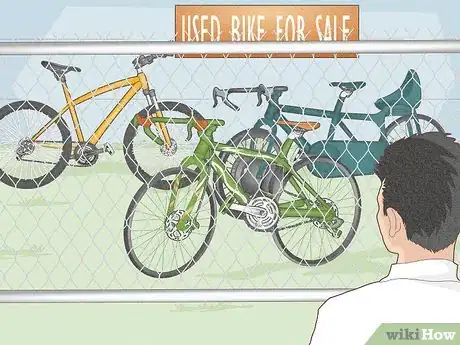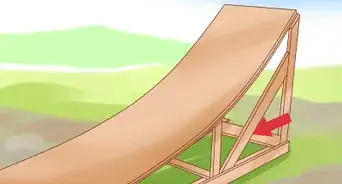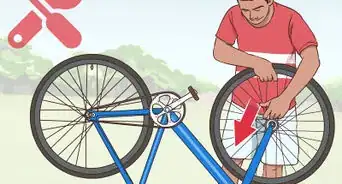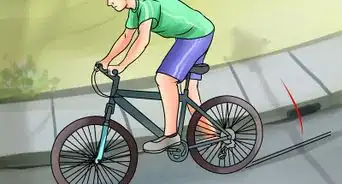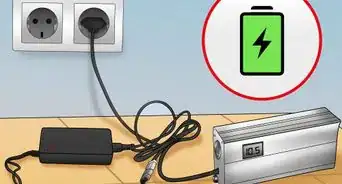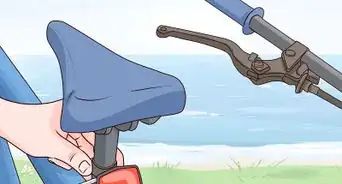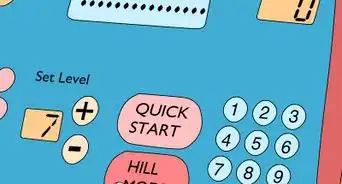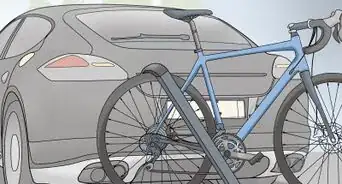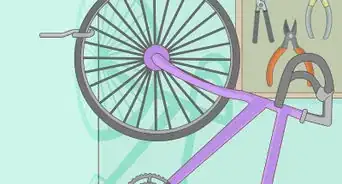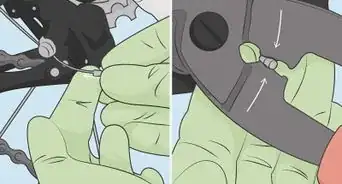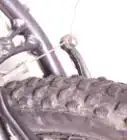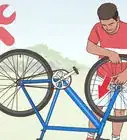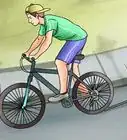This article was co-authored by Jonas Jackel and by wikiHow staff writer, Eric McClure. Jonas Jackel is the Owner of Huckleberry Bicycles, a bicycle retail store based in San Francisco, California. Jonas has over 20 years of experience managing bicycle retail stores and has operated Huckleberry Bicycles since 2011. Huckleberry Bicycles specializes in servicing, repairing, and custom building road, cross, gravel, touring, folding, and e-bikes. Jonas was also previously sat on the Board of Directors for Bike East Bay, a bicycle-advocacy non-profit organization based in Oakland, California.
There are 10 references cited in this article, which can be found at the bottom of the page.
wikiHow marks an article as reader-approved once it receives enough positive feedback. In this case, several readers have written to tell us that this article was helpful to them, earning it our reader-approved status.
This article has been viewed 566,044 times.
Buying a bike can be overwhelming at first, especially since there are so many options out there! The good news is that once you’ve settled on what kind of bike you want to buy, this process is actually pretty straightforward—especially if you don’t have a specific brand in mind. The big thing you’ll want to consider is how you plan on using your bike, since different bikes are designed for different types of riders!
Steps
How do I know what kind of bike to buy?
-
1Choose a road bike if you’ll be traveling primarily on paved roads. Road bikes are designed for paved surfaces, which makes them ideal if you’re riding in a city or using the bike to get to work. They have lighter frames, slimmer tires, and they’re generally a lot easier to maneuver. If you aren’t tackling any off-road trails, get a road bike![1]
- There are many subcategories of road bike, including cyclocross, touring, adventure road, triathlon, and fitness. If you’re going to be using the bike for a specific sport or activity, consider getting one of these specialized bikes.
-
2Pick a mountain bike if you’re hitting the trails. Mountain bikes are best for riding on rocky trails and adventuring off of paved roads. The tires are large and have a thicker tread, which helps to grab the surface and propel you forward when you're going uphill. They tend to be kind of bulky, but that helps them hold up better in rough conditions![2]Advertisement
-
3Go for a gravel bike if you ride on rough terrain. A gravel bike has wide tires, low gearing, dropped handlebars, and stable steering. It's a great option if you like to bike off-road, and you can also ride it on a variety of surfaces from forest tracks to byways.[3]
-
4Look at a hybrid bike for a comfy ride. If you want something smaller than a mountain bike, but bigger than a road bike, look into a hybrid bike. Sometimes known as “comfort” bikes, these bicycles have gears like a mountain bike, but they’re not as bulky or unwieldy. They perform well on pavement, but you can also ride them on smoother dirt paths.[4]
- These bikes are called “comfort” bikes because they usually have wider, padded saddles and suspension systems to absorb the shock of potholes or bumps. This generally makes them super comfortable to ride.
-
5Consider an electric bike if you want some help pedaling. Electric bikes have a built-in battery that help you pedal with ease (or skip the pedaling altogether!). This is ideal if you don’t care about the fitness component, or you have some kind of chronic knee pain that makes riding a standard bike difficult.[5]
- These bikes do tend to be kind of pricey. A decent electric bike will run you $2,000-3,000. They’re also pretty bulky, so they tend to require a lot of storage space.
Is it better to buy a used or new bike?
-
1Pick a new bike if you want durability and have unique requirements. If you’ve got your heart set on getting a specific type of bike and you know it’s the one for you, it’s probably better to buy new since you won’t need to replace it for a long time. Buying new is also a good idea if you really don’t want any headaches in the maintenance and repair department, since you won’t need to replace any components any time soon.[6]
- Every bike will need maintenance eventually. Don’t buy a brand new bike and expect to never need a tune up!
-
2Get a used bike if you’re on a budget or just causally riding. If you’re trying to cut costs or you really don’t care all that much about your paint job being chip-free, just buy a used bike. A used bike may also be a good idea if you enjoy tinkering and fixing things yourself, since you’ll be able to replace the grip tape, chain, or tire if they break down in the future. Just be sure that you don’t buy an obviously damaged or dysfunctional bike.[7]
- You can buy used bikes from most bike shops, but you can also search on Craigslist or Facebook Marketplace if you spot something interesting. Just make sure that you inspect the bike carefully and test it out before you buy it!
What size bike do I need for my height?
-
1Sit on the bike to see if it’s comfortable and sized appropriately. There are all kinds of sizing methods and tricks out there when it comes to figuring out if a bike is the right size for you. You can look at tube measurements and subjective size recommendations all you’d like, but so long as the bike is comfortable for you, it’s totally fine.[8] If you can keep a neutral spine and your knees are almost perfectly straight at the lowest pedal position, it’ll work for you.[9]
- If you want to use a more scientific sizing method, you can! Here are the general recommendations for bike sizes based on your height (the bike size is the distance from the seat post to the crank):[10]
- 4'11" to 5'3" – 13–15 inches (33–38 cm)
- 5'3" to 5'7" – 15–16 inches (38–41 cm)
- 5'7" to 5'11" – 16–17 inches (41–43 cm)
- 6'0" to 6'2" – 17–19 inches (43–48 cm)
- 6'2" to 6'4" – 19–21 inches (48–53 cm)
- 6'4" or taller" – 21 inches (53 cm) or more
- If you want to use a more scientific sizing method, you can! Here are the general recommendations for bike sizes based on your height (the bike size is the distance from the seat post to the crank):[10]
-
2Take a test drive to determine if the bike feels smooth. Once you find a bike that you think might be right for you, take it for a quick test run. Bike around the block, or in the parking lot of the bike shop. If everything feels smooth and you don’t find pedaling uncomfortable, it’s probably a solid bike for you![11]
- Different riders prefer different things in a bike. A large part of this process is simply determining how a bike feels to you. If you aren’t comfortable on a given bike, don’t buy it. If you’re comfortable, it’s worth considering!
How much is it to buy a bike?
-
1A new bike is probably going to start around $300-500. Road bikes typically start around the $300 mark, while a new mountain bike is going to start around $500—at least if you’re buying a quality bike. There are bikes that are cheaper than this, but they may not last as long.[12]
-
2
-
3Used bike prices vary, but they may require more maintenance. If you opt for a used bike, it may require a few adjustments and repairs. You may need a new chain, a fresh saddle, and some new grip tape. You’re probably going to need a tune up relatively soon as well. Take these minor repairs into account when you’re buying a used bike, and assume you’ll end up spending a few hundred on this stuff.[15]
Where should I buy a bike?
-
1Most cycling enthusiasts suggest you buy in-person from a bike shop. The folks who work at bike shops are passionate and knowledgeable, and they’ll be able to advise you on what kind of bike is likely best for you. They’ll also be able to tune or adjust your bike before it leaves the shop so that you have something road-ready as soon as you walk out of the door! Regardless, if you don’t see the bike in person, there’s no way to know if it’s right for you.[16]
- If you don’t live anywhere near a bike shop, check your local outdoors or big box department store. These big retailers often have bikes for sale.
-
2Consider buying online if you want a specific model or bike. Local bike shops can only offer what they’ve got on hand, and if you know exactly what you’re looking for, they may not have it in stock. If you’ve got your eyes set on a specific brand, model, or set of features, buying online may be your best option. The big downside is that you won’t get to test the bike, but if you do your research and know what you want, that may not matter to you.[17]
- Most online bike stores have a live chat feature. If you do buy from an online retailer, reach out through the chat function first. Let them know how tall you are, and what you want in a bike. They’ll be able to give you concrete recommendations regarding the size you likely need.[18]
- This is also a good option if nothing catches your eye at the local bike shop but you have a solid sense for what you’re looking for.
-
3Consider buying a used bike from a private seller to save money. If you want to buy from a private seller who lives in your area, that’s totally fine! You may not want to exchange money before you inspect it in person though, so try to meet in person to get a look at the bike. Keep in mind, since you can only go see one bike at a time, it may take you a long time to find a bike that’s right for you if you go this route.[19]
- Ask the seller how long they’ve had it, why they’re getting rid of it, and what repairs it has needed in the past. If they get kind of twitchy or uncomfortable with the questions, just walk away.
Expert Q&A
-
QuestionHow do you pick the right size bicycle?
 Jonas JackelJonas Jackel is the Owner of Huckleberry Bicycles, a bicycle retail store based in San Francisco, California. Jonas has over 20 years of experience managing bicycle retail stores and has operated Huckleberry Bicycles since 2011. Huckleberry Bicycles specializes in servicing, repairing, and custom building road, cross, gravel, touring, folding, and e-bikes. Jonas was also previously sat on the Board of Directors for Bike East Bay, a bicycle-advocacy non-profit organization based in Oakland, California.
Jonas JackelJonas Jackel is the Owner of Huckleberry Bicycles, a bicycle retail store based in San Francisco, California. Jonas has over 20 years of experience managing bicycle retail stores and has operated Huckleberry Bicycles since 2011. Huckleberry Bicycles specializes in servicing, repairing, and custom building road, cross, gravel, touring, folding, and e-bikes. Jonas was also previously sat on the Board of Directors for Bike East Bay, a bicycle-advocacy non-profit organization based in Oakland, California.
Owner, Huckleberry Bicycles Walk around the sales floor and check out the bikes that you've researched. Tell the salesperson about your abilities and goals, and ask for recommendations.
Walk around the sales floor and check out the bikes that you've researched. Tell the salesperson about your abilities and goals, and ask for recommendations. -
QuestionWhat things should I check on the bicycle while buying it?
 Gaurav MeenaCommunity AnswerCheck if the pedals are easily rotatable while pedaling, if they are bent or if the side-screws touch your feet. Check if the chain is straight, as a bend in the chain can lead to a big accident. Check the handles, seat adjustments and the brakes for manufacturing defects, also make sure that the rim in the tires is not banded. If any of the parts are not properly welded then it can break. If you are buying online, read reviews and take care of form-factor.
Gaurav MeenaCommunity AnswerCheck if the pedals are easily rotatable while pedaling, if they are bent or if the side-screws touch your feet. Check if the chain is straight, as a bend in the chain can lead to a big accident. Check the handles, seat adjustments and the brakes for manufacturing defects, also make sure that the rim in the tires is not banded. If any of the parts are not properly welded then it can break. If you are buying online, read reviews and take care of form-factor. -
QuestionIs it okay to ride a mountain bike on a normal cycling track?
 Community AnswerIdeally you would want to invest in a road bike, but mountain bikes are okay, though you'll experience lag and resistance while pedaling.
Community AnswerIdeally you would want to invest in a road bike, but mountain bikes are okay, though you'll experience lag and resistance while pedaling.
References
- ↑ https://www.consumerreports.org/cro/bikes/buying-guide/index.htm
- ↑ https://www.consumerreports.org/cro/bikes/buying-guide/index.htm
- ↑ https://www.bikeradar.com/advice/buyers-guides/what-is-a-gravel-bike/
- ↑ https://www.consumerreports.org/cro/bikes/buying-guide/index.htm
- ↑ https://www.wired.com/gallery/best-electric-bikes/
- ↑ https://www.nytimes.com/2020/06/18/style/bike-buying-commute-exercise-questions.html
- ↑ https://www.bikeradar.com/features/how-to-buy-a-used-or-second-hand-bike-online/
- ↑ https://www.bikeradar.com/advice/sizing-and-fit/mountain-bike-sizing-what-size-bike-do-i-need/
- ↑ https://ilovebicycling.com/how-to-maintain-proper-cycling-posture/
- ↑ https://www.bicycle-guider.com/bike-articles/bike-size-chart/
- ↑ https://www.consumerreports.org/cro/bikes/buying-guide/index.htm
- ↑ https://www.nytimes.com/2020/06/18/style/bike-buying-commute-exercise-questions.html
- ↑ https://www.consumerreports.org/cro/bikes/buying-guide/index.htm
- ↑ https://www.nytimes.com/2020/06/18/style/bike-buying-commute-exercise-questions.html
- ↑ https://www.bicycling.com/bikes-gear/a20008824/how-to-buy-a-used-bike/
- ↑ https://www.nytimes.com/2020/06/18/style/bike-buying-commute-exercise-questions.html
- ↑ https://www.bicycling.com/bikes-gear/a20018491/how-to-buy-a-bike-online/
- ↑ https://www.bicycling.com/bikes-gear/a20018491/how-to-buy-a-bike-online/
- ↑ https://www.bikeradar.com/features/how-to-buy-a-used-or-second-hand-bike-online/
- ↑ https://www.nytimes.com/2020/06/18/style/bike-buying-commute-exercise-questions.html
About This Article
To buy a bicycle, go with a road bike if you'll mostly be riding on paved roads. If you're more interested in riding on rocky trails, then focus your search on mountain bikes. However, if you plan to spend time on both streets and unpaved roads, look into getting a hybrid bicycle. Once you decide what kind of bike fits your lifestyle, you'll want to make sure that it also fits your body, so know your height and inseam measurements to determine your frame size. For tips on how to buy a bike online, keep reading!














